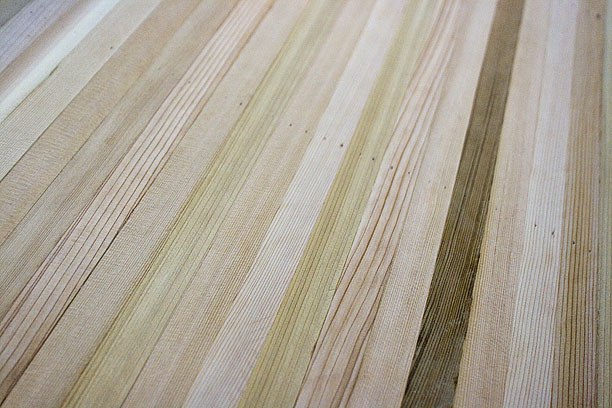Hardware River along The Plank Road
My grandfather used to say that, given enough caulk and putty and paint, he was a pretty good carpenter. Of course, after beer-thirty, his skills diminished considerably, and one could rightly accuse him of boasting, but before noon he could cover up even pretty big mistakes. Me too.
Now that the decks are glassed on top, they can be removed along with the molds, and work moves to the insides. Makeshift frames support the still wobbly decks out of the way against the wall, sprung close to their final curve so they don’t warp.
Stacked Decks
I made a first pass by hand with 60 grit sandpaper on the interiors, which made a lot of sawdust. Then used a fine scouring pad on a grinder to smooth the hollows and curves.
A closer inspection after sanding revealed a few gaps between some of the strips along the bilge. These will have to be filled with a mixture of wood flour and epoxy before glassing. They’re not in the most obvious locations, and as the color of the wood mellows they may not be too pathetically obvious. Grandfather is chuckling, I’m sure.
Wrestled with the chainsaw-blade-eating tree for half the weekend (why in the *&^(*% is there a steel cable running through the middle of the trunk!). Loud power tools make Terri nervous, but she likes to document the atrocities.
Got back to the boats late Sunday and got most of the sanding done. The cabinet scrapers aren’t much help here, and with so much real estate to cover you pull out every tool in the box – drills, grinders, palm sanders, scrapers, etc..
In the end, a fine grit flexible pad on the grinder bends into the curves without gouging, and a small palm sander with medium grit (that’s backwards, I know) removes most of the swirls the grinder leaves behind. This takes off all the rough edges and ridges, and carves the flat planks to a reasonable curve.
Most of the interior will be covered by the decks, so fine finish sanding isn’t really critical except in the cockpit area. Also, unlike the exterior of the hull where smoothness translates to speed, you don’t have to sweat to get a truly smooth surface here. Mostly you want to make it esthetically pleasing, both in look and feel.
There’s a saying from where I grew up that if you want a job done quickly and efficiently, get lazy man to do it. I’m basically lazy. There’s a trick I’ve learned to getting a nice finish when you don’t want to sand every dip, bump and ripple to a perfectly smooth. flat plane: Once you’ve got it reasonably close, go over the whole thing by hand with 0000 steel wool. Power tools skip over the dips and leave them slightly rougher than the surrounding wood. This makes the final finish uneven and splotchy, since the rough surfaces will appear darker than the high points. The steel wool in your hand conforms to the contours and gives a more consistent texture over the whole surface, bumps and hollows included. That’s why a hand rubbed finish looks so good. I forgot to do it to the outsides of the hulls, but did on the decks and it worked well.
Rather than remove more wood with the grinder, making the hulls disconcertingly thin, I’ve sanded away enough so the glass weave will lay flat against the wood and make good contact, removed the ripples from the grinder with the palm sander, and finished off with the steel wool. They should take the finish well, even if the shape is somewhat more organic.
The interiors need maybe one more pass with the fine stuff, then should be ready for the next step.










